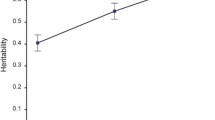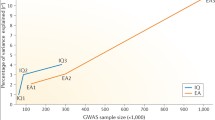Abstract
In The Bell Curve, Herrnstein and Murray claim that a high value for heritability of intelligence limits or constrains the extent to which intelligence can be increased by changing the environment.1 In this chapter it is argued that the calculated numerical value of “heritability” has no valid implications for government policies and that evidence of a nonspecific genetic influence on human mental ability places no constraint on the consequences of an improved environment. On the contrary, a very small change in environment, such as a dietary supplement, can lead to a major change in mental development, provided the change is appropriate to the specific kind of deficit that in the past has impaired development. The results of adoption studies, the intergenerational cohort effect, and effects of schooling also reveal that intelligence can be increased substantially without the need for heroic intervention.
Access this chapter
Tax calculation will be finalised at checkout
Purchases are for personal use only
Preview
Unable to display preview. Download preview PDF.
Similar content being viewed by others
References
Herrnstein, R J., and Murray, C. (1994), The Bell Curve: Intelligence and Class Structure in American Life, The Free Press, New York.
Putnam, C. (1961), Race and Reason. A Yankee View, Public Affairs Press, Washington, D.C.
. Jensen, A. (1969), “How Much Can We Boost IQ and Scholastic Achievement,” in Environment, Heredity, and Intelligence, Reprint series No. 2, Harvard Educational Review,1-123.
Gottlieb, G. (1992), Individual Development and Evolution. The Genesis of Novel Behavior, Oxford University Press, New York.
Lewontin, R. (1974), “The Analysis of Variance and the Analysis of Causes,” American Journal of Human Genetics, 26, 400–411.
McGuire, T. R., and Hirsch, J. (1977), “General Intelligence (g) and Heritability (H 2,b 2 ),“ in I. C. Uzgiris and E Weizmann (Eds.), The Structuring of Experience, Plenum, New York, pp. 25–72.
Wahlsten, D. (1990), “Insensitivity of the Analysis of Variance to Heredity-Environment Interaction,” Behavioral and Brain Sciences,13, 109–161.
Wahlsten, D., and Gottlieb, G. (1997), “The Invalid Separation of Effects of Nature and Nurture: Lessons from Animal Experimentation,” in R. Sternberg and E. Grigorenko (Eds.), Intelligence, Heredity, and Environment,Cambridge University Press, New York, 163–192..
Goldberger, A.S. (1978), “The Nonresolution of IQ Inheritance by Path Analysis,” American Journal of Human Genetics, 30, 442–445.
Kempthorne, O. (1978), “Logical, Epistemological and Statistical Aspects of Nature-Nurture Data Interpretation,” Biometrics, 34,1–23.
Roubertoux, P.L., and Capron, C. (1990), “Are Intelligence Differences Hereditarily Transmitted?,” Cahiers de Psychologie Cognitive10, 555–594.
Taylor, H.F. (1980) The IQ Game. A Methodological Inquiry into the Heredity-Environment Controversy, Rutgers University Press, New Brunswick, NJ.
Fisher, R.A. (1951), “Limits to Intensive Production in Animals,” British Agricultural Bulletin, 4,217–218.
Kempthorne, O. (1990), “How Does One Apply Statistical Analysis to our Understanding of the Development of Human Relationships?,” Behavioral and Brain Sciences, 13, 138–139.
Lewontin, R. C. (1991), Biology as Ideology. The Doctrine of DNA, Anansi, Toronto.
Chase, A. (1977), The Legacy of Malthus. The Social Costs ofthe New Scientific Racism, Knopf, New York.
Gottlieb, G., Wahlsten, D., and Lickliter, R. (in press), “The Significance of Biology for Human Development: A Developmental Psychobiological Systems View,” in R.M. Lerner (Ed.), Theoretical Models of Human Development, Vol. 1, Handbook of Child Psychology, 5th ed., Wiley, New York.
Platt, S.A., and Sanislow, C.A., III (1988), “Norm-of-Reaction: Definition and Misinterpretation of Animal Research,” Journal of Comparative Psychology, 102, 254–261.
Lee S.M., and Bressler, R. (1981), “Prevention of Diabetic Nephropathy by Diet Control in the db/db Mouse,” Diabetes, 30, 106–111.
Surwit, R.S., Kuhn, C.M., Cochrane, C., McCubbin, J.A., and Feinglos, M.N. (1988), “Diet-Induced Type II Diabetes in C57BL/6J Mice,” Diabetes, 37,1163–1167.
Woo, S.L.C. (1991), “Molecular Genetic Analysis of Phenylketonuria and Mental Retardation,” in P.R. McHugh and V.A. McKusick (Eds.), Genes, Brain, and Behavior, Raven Press, New York, pp. 193–203.
Clarke, A.M., and Clarke, A.D.B. (Eds.) (1979), Early Experience: Myth and Evidence, Free Press, New York.
Capron, C., and Duyme, M. (1991), “Children’s IQs and SES of Biological and Adoptive Parents in a Balanced Cross-Fostering Study,” Cahiers de Psychologie Cognitive, 11 323–348.
Schiff, M., Duyme, M., Dumaret, A., and Tomkiewicz, S. (1982), “How Much Could We Boost Scholastic Achievement and IQ Scores? A Direct Answer from a French Adoption Study,” Cognition, 12, 165–196.
Flynn, J.R. (1987), “Massive IQ Gains in 14 Nations: What IQ Tests Really Measure,” Psychological Bulletin,101 171–191.
Clarke, S.C.T., Nyberg, V., and Worth, W.H. (1978), Technical Report on Edmonton Grade III Achievement 1956–1977 Comparisons. Alberta Education, Edmonton.
Ericsson, K.A., Krampe, R.T., and Tesch-Romer, C. (1993), “The Role of Deliberate Practice in the Acquisition of Expert Performance,” Psychological Review, 100, 363–406
Wagner, R.K., and Oliver, W.L. (1995) “How to Get to Carnegie Hall: Implications of Exceptional Performance for Understanding Environmental Influences on Intelligence,” in D.K. Detterman (Ed.), Current Topics in Human Intelligence, Vol. 5, The Environment,Ablex, Norwood, NJ, pp. 87–102.
Weisberg, R.W. (1986), Creativity, Genius and Other Myths, Freeman, New York.
Ceci, S J. (1991), “How Much Does Schooling Influence General Intelligence and its Cognitive Components? A Reassessment of the Evidence,” Developmental Psychology, 27, 702–722.
Heyns, B.L. (1978), Summer Learning and the Effects of Schooling,Academic Press, New York.
Ferreira, F., and Morrison, F.J. (1994) “Children’s Metalinguistic Knowledge of Syntactic Constituents: Effects of Age and Schooling,” Developmental Psychology, 30,663–678.
Varnhagen, C.K., Morrison, F.J., and Everall, R. (1994), “Age and Schooling Effects in Story Recall and Story Production,” Developmental Psychology, 30, 969–979.
Morrison, F.J., Smith, L., and Dow-Ehrensberger, M. (1995), “Education and Cognitive Development: A Natural Experiment,” Developmental Psychology, 31, 789–799.
Bisanz, J., Dunn, M., and Morrison, F.J. (1995) “Effects of Age and Schooling on the Acquisition of Elementary Quantitative Skills,” Developmental Psychology, 31, 221–236.
Hedges, L.V., and Olkin, I. (1985), Statistical Methods for Meta Analysis,Academic Press, Orlando.
Campbell, F.A., and Ramey, C.T. (1994) “Effects of Early Intervention on Intellectual and Academic Achievement: A Follow-Up Study of Children from Low-Income Families,” Child Development, 65, 684–698.
Ramey, C.T., Yeates, K.O., and Short, E J. (1984), “The Plasticity of Intellectual Development: Insights from Preventive Intervention,” Child Development, 55, 1913–1925.
Wasik, B.H., Ramey, C.T., Bryant, D.M., and Spading, J J. (1990), “A Longitudinal Study of Two Early Intervention Strategies: Project CARE,” Child Development, 61,1682–1696.
Ramey, C.T., Bryant, D.M., Wasik, B.H., Spading, J J., Fendt, K.H., and LaVange, L.M. (1992), “Infant Health and Development Program for Low Birthweight, Premature Infants: Program Elements, Family Participation, and Child Intelligence,” Pediatrics, 89, 454–465.
Achenbach, T.M., Howell, C.T., Aoki, M.F., and Rauh, V.A. (1993), “Nine-Year Outcome of the Vermont Intervention Program for Low Birth Weight Infants,” Pediatrics, 91, 45–55.
Brooks-Gunn, J., Klebanov, P.K., Liaw, E, and Spiker, D. (1993), “Enhancing the Development of Low-Birthweight, Premature Infants: Changes in Cognition and Behavior Over the First Three Years,” Child Development, 64, 736–753.
Editor information
Rights and permissions
Copyright information
© 1997 Springer Science+Business Media New York
About this chapter
Cite this chapter
Wahlsten, D. (1997). The Malleability of Intelligence Is Not Constrained by Heritability. In: Devlin, B., Fienberg, S.E., Resnick, D.P., Roeder, K. (eds) Intelligence, Genes, and Success. Springer, New York, NY. https://doi.org/10.1007/978-1-4612-0669-9_4
Download citation
DOI: https://doi.org/10.1007/978-1-4612-0669-9_4
Publisher Name: Springer, New York, NY
Print ISBN: 978-0-387-94986-4
Online ISBN: 978-1-4612-0669-9
eBook Packages: Springer Book Archive




